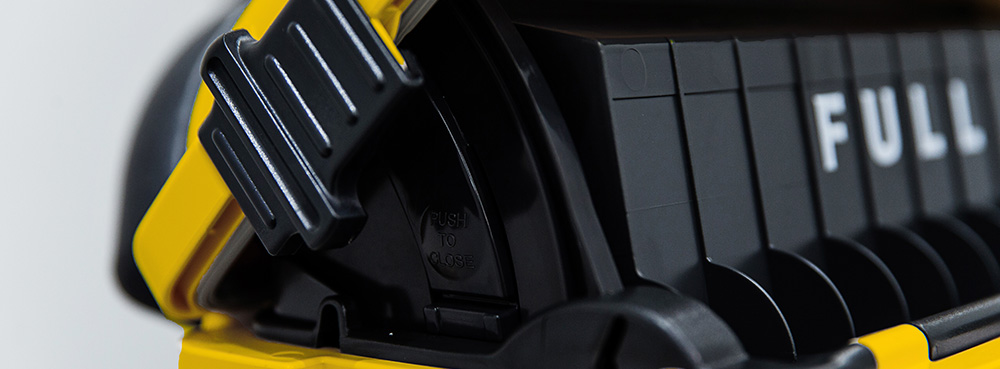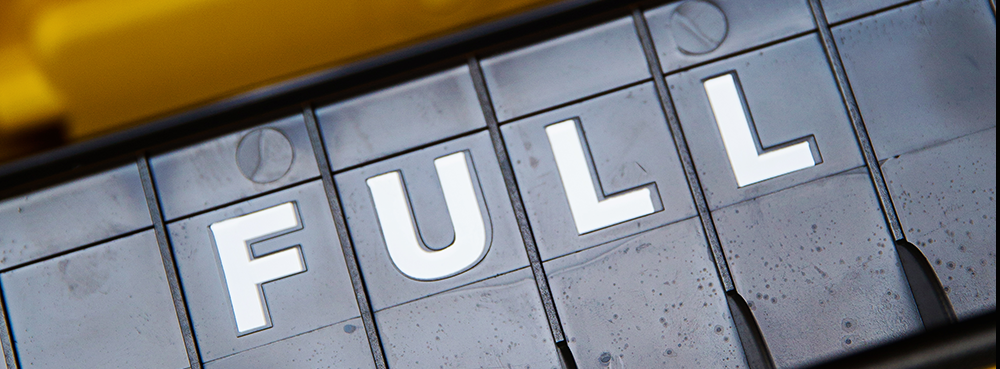Sharps Container Overfilling? No more!

Editor’s note: This post was originally published in June 2018 and has been completely revamped and updated for accuracy and comprehensiveness.
Have you heard what the Royal College of Nursing has said about sharps injuries?
32% of ALL sharps injuries are disposal-related!
It’s been identified through multiple studies that the lack of an overfill mechanism in sharps containers is one of the highest contributors to container-associated needlestick injuries.
NHS organisations are obligated to keep healthcare workers safe in the workplace – one key way to do that is with the introduction of safety-engineered devices, such as ISO-compliant reusable sharps containers.
Before looking at how they can make a difference though, it’s worth considering how they came about…
TOPICS WE WILL COVER:
1 / The need to interrupt human behaviour.
2 / How we came to develop our reusable sharps containers.
3 / A solution that makes safety a standard, rather than a choice.
4 / What to do if you see an overfilled sharps container.
5 / Are you looking for a safer sharps waste management system?
The Need to Interrupt Human Behaviour
There are numerous ways to prevent needlestick injuries and minimise risks but one of the most effective methods is to interrupt human behaviour.
Healthcare environments are fast-paced and the question of ‘Who replaces the sharps container?’ is almost akin to ‘Who replaces the toilet roll?’… met with a uniquely similar answer – “Someone else will do it.”
The scenario of a sharps bin being filled beyond its recommended capacity is not uncommon and is one that consistently puts patients and healthcare workers at risk.
As an industry, we’ve tried to subvert the design flaws of sharps containers by enforcing a discipline of replacing containers before the contents reach the fill line. But the practice of replacing sharps bins at partial capacity is neither sustainable nor cost-effective and while assisting in occupational risk prevention, simply doesn’t eliminate human error.
How We Came to Develop Our Reusable Sharps Containers
At 22 years old, our founder, Dan Daniels encountered a healthcare worker who had contracted HIV as a result of a needlestick injury – this prompted him to want to make a difference.
Dan spent the following two years analysing needlestick injury data to identify every scenario where sharps container design could have played a factor in prevention. He also interviewed countless clinicians to understand the workflow around sharps disposal and environmental pressures that impact safety in a healthcare setting.
He concluded that one of the most prevalent causes of injuries was containers being overfilled, leaving healthcare workers susceptible to being stuck by exposed sharps.
Dan’s conclusion to resolving this issue through safety engineering was simply… “Let’s not make overfilling an option.”
By nature of its intended use, a sharps bin should be designed through a process of safety engineering – a discipline assuring that the device provides an acceptable level of safety.
Thus, the Sharpsmart reusable sharps container was born.
A Solution That Makes Safety a Standard, Rather Than a Choice
Safer sharps containers are a key aspect of the hierarchy of controls – the framework created by the RCN as part of their Sharps Safety Guidance for protecting healthcare workers from sharps injuries.
Sharpsmart’s reusable is the only sharps waste containment system in the world with a tray that self-locks when contents reach the fill level. It removes human choice from the equation – protecting healthcare workers who by nature would put patient needs ahead of their own safety.
It also ensures that costs and environmental impact are managed at a facility level with sharps container capacity being fully realised without any risk to users.
The Sharpsmart container removes the onus for safety from the user, catering to a wide spectrum of human behaviour – it passively protects users 24 hours a day and doesn’t require staff to constantly monitor fill-reach.
The safety-engineered design ensures that a sharps container overflowing is an impossible scenario.
Sharpsmart reusable containers are much more than a sharps container – they’re safety-engineered devices that have been clinically proven to reduce needlestick injuries by up to 87%.
What to Do if You See an Overfilled Sharps Container
Depending on you organisation and facility, the protocol may vary slightly but there are some basic steps to take if you see an overfilled sharps container in your workplace…
Don’t add to it
You should never try to force additional sharps into an already overfilled container. This can be extremely dangerous and increase the risk of needlestick injuries.
Isolate the container
If you come across an overfilled sharps box, isolate the container and prevent anyone from using it. This can be done by placing it in a secure area and marking it as ‘Full’ to alert others.
Inform a supervisor or manager
Report the overfilled sharps container to your immediate supervisor or manager. This should be done promptly so that the issue can be addressed as soon as possible.
Replace the container
A new, empty sharps container will be needed to replace the overfilled one. This ensures that a safe and secure container is available for disposing of sharps waste.
Document the incident
It’s always best practice to document the incident, including the time, date, location, and any actions taken. This documentation can be useful for tracking and improving safety measures.
Education and training
Healthcare facilities should provide education and training to staff on the proper disposal of sharps and the importance of not overfilling containers. All clinical staff should be aware of the potential risks and take appropriate precautions to minimise the chances of needlestick injuries.
Follow facility protocols
Different healthcare facilities may have specific protocols for handling overfilled sharps bins. You should follow the guidelines and procedures in place when dealing with this issue.
It’s crucial to prioritise safety and take immediate action when you encounter an overfilled sharps container to protect both yourself and your patients from the risk of injury.
All healthcare facilities should have clear policies and procedures in place to address this issue and ensure the safe disposal of sharps waste.
Are You Looking for a Safer Sharps Waste Management System?
Don’t accept an overflowing sharps bin to be an acceptable standard – it’s a hazard for you, your fellow healthcare workers, and your patients. If you’d like more information on the unique safety features of Sharpsmart’s clinically-designed sharps container or would like to introduce them to your facility, please don’t hesitate to get in touch.
Contact us today and protect healthcare workers in your facility from sharps injuries.

